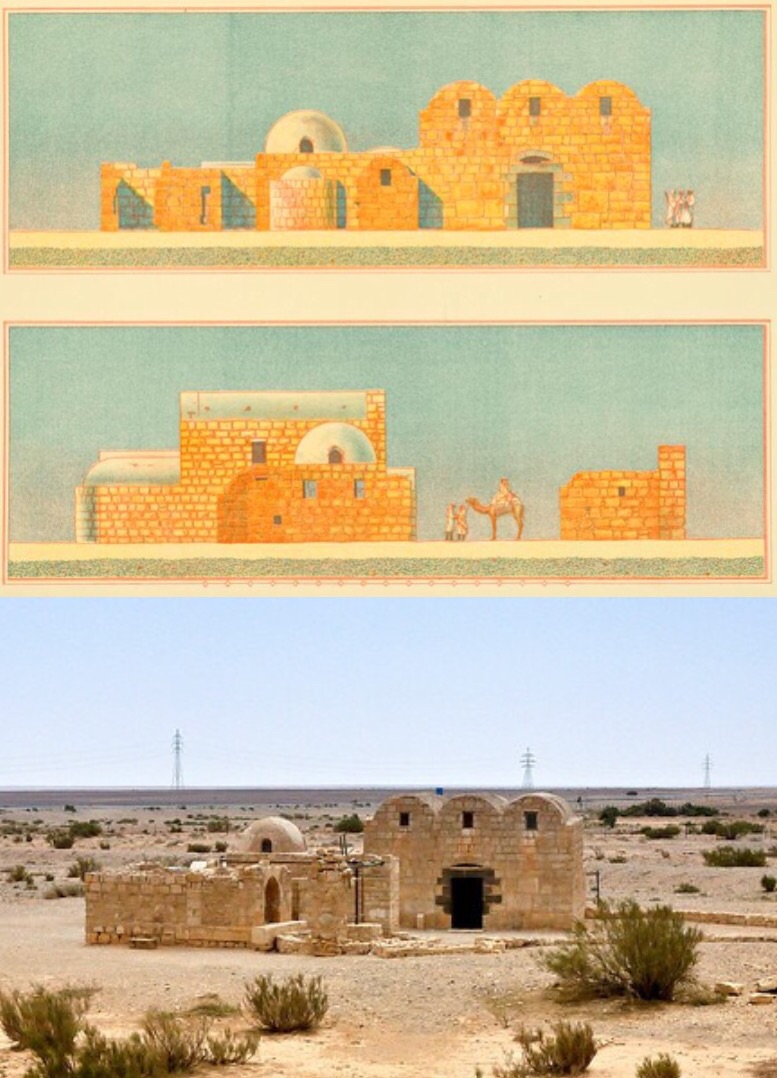Imagine it is late spring in 1898 and you are a 29-year-old Moravian-born priest traveling with a tribe of bedouins to a desolate spot to look at some wall paintings in an abandoned building. You walk in and see colorful frescoes covering the walls and ceilings. In astonishment you see a whirl of dancing girls, hunting scenes, musicians and more. After 40 minutes you have to rush out and dash off because an enemy tribe is approaching. When you return to Vienna to present your findings no one believes you. The few photos you took are lost. The painted scenes you saw don’t fit with their timelines or their ideas, you have no proof, you must be a liar.


And what frescoes! To put it mildly there are girls, girls and partially clothed girls. And in between there are hunting scenes, flora, cavorting fauna and on one vaulted ceiling 32 panels of carpenters, masons and blacksmiths.

Other surviving citadels had hunting scenes, but no girls, and certainly no display of working craftsmen. But if you think about it, why not? While your guests soak in the warm waters of the caldarium surrounded by these fantastic paintings you are impressing them with your power and wealth. Including the panels of craftsmen may seem an anomaly but is another indication of material wealth and resources. The citadel and bath works were built and decorated with the skills of a small army of carpenters, masons, blacksmiths and artists. Thanks to this 8th-century showmanship, and the persistence of Alois Musil, we have more pieces to add to the woodworking record.
The panels with the sawyers and the worker on the bench are the only woodworking panels still intact enough to discern details (likely due to their locations away from water leaks). Both panels have had some restoration work. The Roman workbench detail from Pompeii (dated about 660 years earlier) is included for comparison. The craftsmen panels don’t show any innovations in tools or techniques, rather a continuation of Roman-era traditions.
The frescoes have sustained damage from almost 1,300 years of exposure to weather, water leaks, camp fires, vandalism and unfortunate efforts at conservation. Musil, accompanied by artist Alphons Leopold Mielich, attempted to treat some the wall frescoes with chemicals causing pigments to fragment and fall off. While attempting to remove sections for transport to Vienna, other portions of frescoes were destroyed. The few sections that did make it to Europe are in museums in Vienna and Berlin. Qusayr’Amra was designated a UNESCO site in 1985 and current conservation efforts are under the direction of the World Monuments Fund.
In 1909 drawings made by Mielich were published in a two-volume folio and included reconstructions of the larger frescoes. The New York Public Library has one volume of the folio and a digital copy is available on line under the title Kusejr’Amra. I was able to match a few of the 1909-era drawings with more recent photographs.
— Suzanne Ellison












This has to be one of my favorite post ever. Love to know that we as a civilization have walked a long journey and sometimes we forget that thousands of years ago we were already as sophisticated as we will ever be. How cool (or depressing, if you are into that) is that?
You go today and ask to your 21st century builder if they can build a catalan vault for you (*), Heck, a simple stone arch is basically impossible to build now.
(*) Well, there are a couple of wacky academia guys doing some amazing stuff in rural parts but that’s an anomaly
Leonardo, the construction of a Catalan vault is fascinating (to me) and I wish it were incorporated into more modern buildings.
It occurs to me that the roman benches in these frescoes (Pompeii specifically) have the legs on one side splayed towards the corners of the bench, but on the other side they are splayed to be in the same line as the top. Specifically, the legs on the right side in the 3 fresco photos. If this is so, and not me misreading the attempts at perspective on the part of the artist, then I suspect this arrangement would prevent racking while planing. Also, it seems to me that this arrangement would be more stable on a dirt floor than four splayed legs would be, especially if the two legs in line with the top rocked a bit in their socket(s).
Am I the only one who sees/thinks this?
Images of stone structures in the desert always make me curious. Did the local climate change dramatically into a desert, or were they taking advantage of an water spring? What was the advantage or need for a kick butt bath house in what looks like a desert?
They took advantage of a nearby spring and built a hydrauilc system to bring the water into the bath house. The bath house was part of a citadel (or castle) complex and the only building still standing.
Another wonderful post! Makes me want to go back to Petra and search nooks and corners for possible pictures of artisans at work (or under ledges for initials of the carvers). Where on earth do you find these things, Ms. Ellison?
Great history lesson. How is it known that this wasn’t a structure originally built (or at least started) by the Romans and then later redone in the 2nd Calif? Lots of the antiquities were simply redos of earlier structures on the same site.
Were there any early examples of the Anarchist’s Tool Chest in any of the frescos?